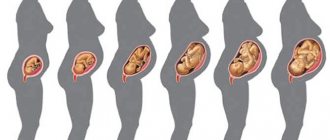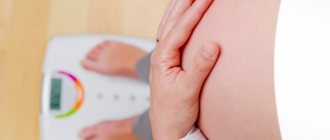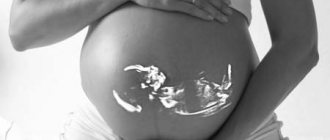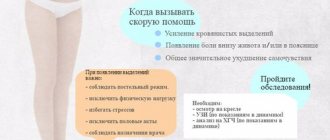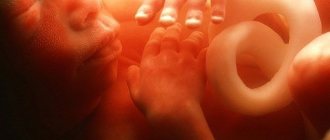Throughout the nine months, every mother worries about the correct development of the baby. It is to ensure full control over the development of the child in the womb and timely detection of any abnormalities that pregnant women are strongly recommended to regularly visit a leading doctor in order to find out the size of the fetus by week of pregnancy.
- 1 What indicators are taken into account?
- 2 Fetal size by week of pregnancy
- 3 Biparental fetal size by week
- 4 Weight indicators
- 5 Interesting comparisons
Accurate diagnosis involves the use of ultrasound methods. Based on the results obtained, the specialist can determine how proportionally the baby is developing, and whether the data obtained regarding growth and development correspond to established standards.
Pregnancy
To begin with, it is worth talking about how conception occurs. A healthy woman ovulates every month. At this moment, the egg leaves the place of its maturation and enters the abdominal cavity. Moving through the fallopian tubes, the gamete meets the sperm and fertilization occurs. It is worth noting that this requires unprotected sexual contact between a man and a woman.
After this, the future fertilized egg begins to continuously divide and move into the uterus. It is here that the embryo will develop, which will subsequently become a completely independent viable human organism.
Interesting topics
- Few expectant mothers know what kind of examinations need to be taken while carrying a child. One of the most important is screening. During this examination, you need to undergo an ultrasound and donate blood. Find out when the first screening is scheduled and how to prepare for it.
- The second screening during pregnancy is usually prescribed in the second trimester.
- Determining hCG is also very important for expectant mothers. This indicator is needed to determine the hormone that is produced in a woman’s body during pregnancy.
- Some mothers are concerned about the safety of ultrasound examinations. We invite you to find out how often you can do an ultrasound during pregnancy so as not to harm you and your baby.
Girls, tell me if you did fetometry. What were your results and did they match the parameters of our table? Do you think this ultrasound helps in identifying or preventing pathologies in babies?
How to determine the size of the fertilized egg?
Pregnancy was always calculated by week. Even in ancient times, when there was no modern technology and equipment, doctors did not count in months, but in periods of seven days. There are several ways to determine the size of the fertilized egg by week. Let's look at them:
— Manual inspection. This method has a large error. During the examination, the doctor inserts two fingers into the vagina and with the other hand probes the uterus through the abdominal cavity. By establishing the approximate size of the reproductive organ, the physician determines the size of the fertilized egg by week. It is worth noting that during palpation the doctor does not take into account the number of embryos in the uterus. That is why there is a fairly high probability of inaccuracy of this method. The established period may differ from the actual one by approximately 14 days.
— Ultrasound examination. This method, which allows you to determine the size of the fertilized egg by week, is more accurate. However, in this case the error may be approximately seven days. It is worth noting that a lot depends on the attentiveness and professionalism of the doctor, as well as on his equipment. Modern sensors allow you to set the period not only in weeks, but also in days.
Norms and deviations
- When performing fetal fetometry, the parameters shown in the table below are considered normal But sometimes the results of fetometry may not coincide with the data in the table. In this case, there is no need to sound the alarm, because these data are average and therefore relative. In addition, you need to take into account the individual structure of each person. If the parents of the baby are small, then with a high degree of probability the fetus will also be small. This also applies to other parameters, such as chest volume, abdomen and head size. There is also spasmodic, that is, uneven development of the fetus, in which the baby first lags behind in development, and then suddenly reaches all the necessary indicators.
- Anomalies include delayed fetal development (hypotrophy), that is, when the size of the fetus does not correspond to the norm. This can only be diagnosed by a doctor after carefully studying the test results. It will take into account the functioning of the placenta, the location of the fundus of the uterus and the health status of the expectant mother. We can talk about developmental delay if the identified delay exceeds 2 weeks. In this case, it is necessary to distinguish between symmetrical hypotrophy, when all organs are reduced equally, and asymmetrical: the skeletal system and brain are equally developed, and some organs or organ systems lag behind in development.
Early pregnancy
Some representatives of the fairer sex, as soon as they receive a positive pregnancy test result, go for an ultrasound examination. What is the size of the fertilized egg during this period? 4 weeks are characterized by the following data. The doctor may not see the formation at all on the monitor screen. What can we say about the embryo! With good equipment, a physician can see a point, the diameter of which usually does not exceed 2-4 millimeters. However, the specialist will say with confidence that this is pregnancy.
How does a child grow?
The baby's growth begins 12 hours after conception. During the first 12 hours, the first cell of his body is formed, which will give rise to everything else. It is called a zygote. Maternal and paternal reproductive cells (egg and sperm) take part in its formation. They merge, exchange genetic information, give up 23 chromosomes, and after 12 hours, just imagine, a completely new organism settles inside the woman.
Already at this stage, the cell contains all the information about the future person - it is known what gender the baby will be born, what kind of eyes and ears he will have, whether he will be tall or short, fat or thin. The cell contains information about what diseases he inherited from his ancestors, where his moles will be located, whether he will have talent for music, sports, science, what his psychotype will be.
And in the first days after conception, the zygote is intensively fragmented without increasing in size. That is, the number of cells within a single cell increases, but the overall size of the cell does not. About a week after conception, the baby becomes a blastocyst and attaches to the wall of the uterus, where it will spend the next nine months.
It should be noted that in the first trimester all embryos grow at approximately the same rate.
During this period, all the forces of the tiny organism are devoted not to growth as such, but to the formation of internal organs. Embryogenesis processes take place - the heart, intestines, spine, brain, cerebellum, kidneys, stomach, genitals, and so on are formed. From 10 weeks, the baby turns from an embryo into a fetus and remains so until birth.
After embryogenesis ends, children grow differently. Everyone has their own genetic program - some are destined to be tall and others short, some will be chubby and others thin, influenced by race, ethnicity, parental genes and partly the gender of the child. Therefore, the size of the baby in the first trimester is the most informative in order to determine the exact duration of pregnancy.
From the second trimester, growth and weight gain become the main task for the baby in the womb. And the growth rate already indicates how well the baby feels - whether he has enough oxygen, nutrients, whether everything is fine with him.
Ultrasound standards are fetometry. Fetometric indicators are quite arbitrary, and in each specific case they may differ from the statistical average, and therefore it is not possible to fit all children to one standard. All sizes that we will talk about below are only average, typical for children, according to statistics.
Fetal development period: 5 weeks
What should be the size of the fertilized egg in this case? 5 weeks are characterized by an average internal diameter of 6 to 10 millimeters. In this case, good equipment and a competent specialist can determine the exact number of days. So, what is the size of the fertilized egg by week and day?
- 6 or 7 millimeters corresponds to a period of 5 weeks and 3 days;
- 8 millimeters corresponds to a period of 5 weeks and 4 days;
- 9 millimeters corresponds to a period of 5 weeks and 5 days;
- 10 millimeters corresponds to a period of 5 weeks and 6 days.
Decoding the results
No matter what week the ultrasound examination is performed, the biparietal size is measured first.
At the same time, the LZR (frontal-occipital size) is measured - along the major axis from the forehead to the back of the head. However, the key parameter remains the biparietal size: it is this that is used to determine the duration of pregnancy. With particular accuracy, this can be established in the period of 12-28 weeks.
If you look at the table of normal indicators, then from one week of fetal development to the next you can observe an increase in these two indices. Taking into account all the indicators, as well as the BPR, the doctor determines the possibility of childbirth naturally, and also establishes pathological changes.
Duration six weeks
What is the size of the fertilized egg at this stage? 6 weeks of pregnancy are characterized by an average internal diameter of the formation from 11 to 18 millimeters. In this case, most often the embryo is already identified; its coccygeal-crimetal size can be measured. This indicator allows you to more clearly determine the age of the fetus. Based only on the values of the average internal diameter, we can derive this pattern (all measurements are indicated in millimeters):
- 11 corresponds to exactly 6 weeks;
- 12 corresponds to 6 weeks and 1 day;
- 13 corresponds to 6 weeks and 2 days;
- 14 corresponds to 6 weeks and 3 days;
- 15 corresponds to 6 weeks and 4 days;
- 16 and 17 correspond to 6 weeks and 5 days;
- 18 corresponds to 6 weeks and 6 days.
11-20 weeks
11 week
The critical stage of development is virtually over. The weight of the fetus reaches 8 g, the “height” is 5 cm. From this moment, the embryo enters the fetal stage. The heart is working fully, the formation of blood vessels is completed. The placenta becomes dense. The liver occupies 10% of the body. The intestines make the first movements similar to peristalsis.
The genital organs are increasingly formed. Eye color is determined and the sense of smell appears. Palms and fingers become sensitive.
12 week
Critical moments for fetal development depend more on the health and lifestyle of the mother. The body length ranges from 6-9 cm. The unborn child already has fingers and nails are forming. The gastrointestinal tract organs are completing their formation. The immune system is improved.
Week 13
The first trimester ends, the critical cycle is completed. The baby teeth are fully formed, muscle and bone tissue continues to form, and the digestive system develops. The genital organs are differentiated. The child’s “height” reaches 8 cm, weight – 15-25 g.
Week 14
The baby is actively growing and developing. Its weight is 30-40 g, and its height is from 8 to 10 cm. The resemblance to a person is increasing. In case of multiple pregnancy, the expectant mother can feel the movements of the children, who are becoming more and more active. The bone skeleton grows, ribs are formed. The movements of the diaphragm resemble breathing. All organs and systems are fully formed. The child has an Rh factor and blood type.
Embryo size at seven weeks
What is the internal diameter of the ovum at this stage? Data suggests that the average may range from 19 to 26 millimeters. In this case, the embryo and the yolk sac present in the egg cavity are already clearly visible. These indicators indicate that the pregnancy is progressing. So, how does the size of the fertilized egg change at a given time?
- 19 mm is obtained at exactly 7 weeks;
- 20 mm - at 7 weeks and 1 day;
- 21 mm - at 7 weeks and 2 days;
- 22 mm - at 7 weeks and 3 days;
- 23 mm - at 7 weeks and 4 days;
- 24 or 25 mm - at 7 weeks and 5 days;
- 26 mm - at 7 weeks and 6 days.
The role of ultrasound examinations in assessing the development of the baby
It is difficult to overestimate the role of ultrasound examination in the diagnosis of intrauterine development. Here is the data this procedure produces :
- Data measuring the child’s body and his limbs, as well as the volume of the chest and head.
- Exact gestational age.
- Detection of pathologies in the early stages and the ability to correct them or, in case of serious problems, artificially terminate the pregnancy to preserve the health and life of the mother.
- In combination with other tests, it will help determine possible diseases of the child.
- Determines the advisability of a cesarean section.
Gestational age 8 weeks: fertilized egg size
At this stage, the doctor, during an examination with an ultrasound sensor, can detect indicators in the range from 27 to 34 millimeters. However, you should not rely only on the values that the average internal diameter has when setting the deadline. At this time, the embryo helps to more accurately determine the age of pregnancy, or rather, its length from the crown to the tailbone. So, if you focus only on the fertilized egg, the dimensions by week and day will be as follows:
- 27 millimeters is exactly eight weeks;
- 28 millimeters is 1 day and 8 weeks;
- 29 millimeters is 2 days and 8 weeks;
- 30 or 31 millimeters is 3 days and 8 weeks;
- 32 millimeters is 4 days and 8 weeks;
- 33 millimeters is 5 days and 8 weeks;
- 34 millimeters is 6 days and 8 weeks.
Weight indicators
Of course, it is not possible to establish the exact weight of the fetus through ultrasound examination, so experts rely on other sizes and established norms. For the first time, the weight of the fetus is indicated in the eighth week, from which it becomes possible to obtain the first necessary data.
Table 3. Fetal weight by week
| Period | Weight indicators, g |
| 8 week | 1 |
| Week 9 | 2 |
| 10 week | 4 |
| 11 week | 7 |
| 12 week | 14 |
| Week 13 | 23 |
| Week 14 | 43 |
| Week 15 | 70 |
| Week 16 | 100 |
| Week 17 | 140 |
| Week 18 | 190 |
| Week 19 | 240 |
| Week 20 | 300 |
| 21 weeks | 360 |
| Week 22 | 430 |
| Week 23 | 501 |
| Week 24 | 600 |
| Week 25 | 660 |
| Week 26 | 760 |
| Week 27 | 875 |
| Week 28 | 1005 |
| Week 29 | 1153 |
| Week 30 | 1319 |
| 31 weeks | 1502 |
| Week 32 | 1702 |
| Week 33 | 1918 |
| 34 week | 2146 |
| Week 35 | 2383 |
| Week 36 | 2622 |
| Week 37 | 2859 |
| Week 38 | 3083 |
| Week 39 | 3288 |
| 40 week | 3462 |
Nine weeks
This time period is characterized by the size of the fertilized egg from 35 to 43 millimeters. In this case, it is already possible to detect the heartbeat of the embryo, which also, to some extent, makes it possible to more accurately determine the gestational age.
- 35 mm corresponds to 9 weeks exactly;
- 36 or 37 mm – 9 weeks. + 1 day;
- 38 mm – 9 weeks. + 2 days;
- 39 mm – 9 weeks. + 3 days;
- 40 or 41 mm – 9 weeks. + 4 days;
- 42 mm – 9 weeks. + 5 days;
- 43 mm – 9 weeks. + 6 days.
Fetal fetometry table
I trimester
| Week of pregnancy | Weight, g | Height, cm | DHA, mm | DB, mm | BPR, mm |
| 11 | 11-12 | 6,8-6,9 | 20-21 | 7-8 | 18-19 |
| 12 | 18-19 | 8,2-8,3 | 23-24 | 9-10 | 21-22 |
| 13 | 30-31 | 10-11 | 24-25 | 12-13 | 24-25 |
II trimester
| 14 | 52-53 | 12,3-12,5 | 26-27 | 16-17 | 28-29 |
| 15 | 77-78 | 14,2-14,4 | 28-29 | 19-20 | 32-33 |
| 16 | 118-119 | 16,4-16,6 | 34-35 | 22-23 | 35-36 |
| 17 | 160-161 | 18-18-5 | 38-39 | 24-25 | 39-40 |
| 18 | 217-218 | 20,3-20,5 | 41-42 | 28-29 | 42-43 |
| 19 | 270-275 | 22,1-22,5 | 44-45 | 31-32 | 44-45 |
| 20 | 345-350 | 24,1-24,3 | 48-49 | 34-35 | 47-48 |
| 21 | 416-420 | 25,9-26 | 50-51 | 37-38 | 50-51 |
| 22 | 506-520 | 27,8-27,9 | 53-54 | 40-41 | 53-53 |
| 23 | 607-630 | 29,7-30 | 56-57 | 43-44 | 56-56 |
| 24 | 733-740 | 31,2-31,5 | 59-60 | 46-47 | 60-61 |
| 25 | 844-851 | 32,4-32,6 | 62-63 | 48-49 | 63-64 |
| 26 | 969-1000 | 33,9-34 | 64-65 | 51-52 | 66-67 |
| 27 | 1135-1150 | 35,5-35,9 | 69-70 | 53-54 | 69-70 |
III trimester
| 28 | 1319-1350 | 37,2-37,6 | 73-74 | 55-56 | 73-74 |
| 29 | 1482-1485 | 38,6-39 | 76-77 | 57-58 | 76-77 |
| 30 | 1636-1640 | 39,9-40 | 79-80 | 59-60 | 78-79 |
| 31 | 1779-1780 | 41,1-41,5 | 81-82 | 61-62 | 80-81 |
| 32 | 1930-1935 | 42,3-42,6 | 83-84 | 63-64 | 82-83 |
| 33 | 2088-2090 | 43,6-43,8 | 85-86 | 65-66 | 84-85 |
| 34 | 2248-2250 | 44,5-44,8 | 88-89 | 66-67 | 86-87 |
| 35 | 2414-2420 | 45,4-45,6 | 91-92 | 67-68 | 88-89 |
| 36 | 2612-2620 | 46,6-46,8 | 94-95 | 69-70 | 89,5-90 |
| 37 | 2820-2825 | 47,9-48 | 97-98 | 71-72 | 91-92 |
| 38 | 2992-3000 | 49-49,3 | 99-100 | 73-74 | 92-93 |
| 39 | 3170-3175 | 50,2-50,5 | 101-102 | 75-76 | 93-94 |
| 40 | 3379-3380 | 51,3-51,5 | 103-104 | 77-78 | 94,5-95 |
Embryo age: ten weeks
At this stage of development, the fertilized egg is in the range of 44 to 50 millimeters. The most accurate values would be:
- 44 millimeters is exactly 10 weeks;
- 45 or 46 millimeters is 10 weeks and 1 day;
- 47 millimeters is 10 weeks and 2 days;
- 48 or 49 millimeters is 10 weeks and 3 days;
- 50 millimeters is 10 weeks and 4 days.
Further measurement of the average internal diameter is already pointless. During the examination, specialists often use coccygeal-croneal measurements and other data. For example, approximate weight, height from head to toe, volume of head, abdomen and chest. At this time, the fetus is already moving and showing all signs of vital activity.
From poppy seed to newborn: fetal size for each week of pregnancy
3 weeks pregnant
Your baby is now the size of a poppy seed. The size of the embryo is only 2 mm. It is at this stage of pregnancy that his small but large heart begins to beat. If you come for an ultrasound, the doctor will be able to assess the condition of your unborn child based on the heartbeat.
4 weeks pregnant
By the end of the first month of intrauterine development, the baby increases in size by about 3 times. However, it is still very small: the length of the embryo is only 3 mm. It is the size of a sesame seed. Right now the formation of internal organs is taking place: lungs, stomach, liver, pancreas, endocrine glands.
5th week of pregnancy
At the fifth week of pregnancy, the baby is the size of a sunflower seed. Its length is only 5 mm. By the end of this week, an amazing event will occur: embryonic gonoblasts will form - the precursors of germ cells (sperm in boys and eggs in girls). Just imagine: already now your unborn baby has the beginnings of future children, your grandchildren!
6th week of pregnancy
In the sixth week of pregnancy, your unborn baby's face and fingers begin to form, and the formation of the outer ear and eyeball begins. By the end of this week, the embryo is already the size of a chickpea pea! Its length is 10-12 mm. Eggs of this size are laid by the tiniest hummingbirds.
7 weeks pregnant
At seven weeks pregnant, your baby is the size of a bean. Its length is already 16 mm. Right now his tiny arms and legs are forming. The child floats freely in the amniotic fluid, in his own microcosm. About half of the small body is the head.
8 weeks pregnant
By the beginning of the eighth week of pregnancy, the length of the embryo is already 15-20 mm. His body begins to straighten. Nostrils, ears, eyes are forming, and by the end of the week the eyelids will be formed. You don’t feel it yet, but the baby is moving his arms and legs. Rapid development of the brain continues. Starting from this period, the cerebral cortex stands out, which already has a fairly significant number of convolutions. The length of the fetus by the end of the eighth week is 40 mm and your baby weighs like an orange slice - about 5 grams...
Your baby is now the size of an unripe olive. Its length is 2.4 cm. Thumbelina was this size.
9 weeks pregnant
Now your baby is the size of a large grape. Its length is only 3.1 cm. About this height was Boy-Thumb in the fairy tale. A nine-week-old embryo fully becomes a little person. From this moment on, it is no longer called an embryo, but a fetus. Your unborn baby readily sucks his thumb. His heart beats from 130 to 150 beats per minute. Take care of him: he is already capable of feeling pain.
10th week of pregnancy
Your baby is now the size of candy. Its length is 4-6 cm. It weighs about 10-15 g. By the end of the tenth week of its development, the development of the diaphragm is completed - soon it will take an active part in breathing. In place of the “tail” the buttocks develop. In response to stimuli (light, sound), he turns his head.
11th week of pregnancy
This week the baby is the size of an apricot. The length of the fetus is 5-7 cm. It weighs about 14 g. The body proportions of the unborn baby are still unusual: it has a large head, a small body, long arms and short legs. At the 11th week, the placenta is already working at full capacity: it ensures an uninterrupted supply of blood enriched with nutrients and oxygen to the fetus, and the removal of fetal metabolic products and carbon dioxide.
12th week of pregnancy
At 12 weeks of pregnancy, the baby is already the length of a pea pod. Its length is 7-8 cm. It weighs about 23 g. At twelve weeks of pregnancy, the child reacts to light, warmth, noise, and touch. The baby is still very small, but he has eyelids, nails, he is finally formed, and all the organ systems of this tiny organism have begun to work. Starting at this age, the fetus makes rare rhythmic movements of the chest muscles as if it were breathing. This is how your baby practices before taking his first deep breath...
13th week of pregnancy
Your baby is now the size of a fig. Its length is 8 cm, and by the end of the week it will be 11 cm. It weighs about 30-40 g, like a barely hatched chicken. Your baby's face is fully formed, the ears and nose are clearly visible. I wonder who he looks like?
14th week of pregnancy
At fourteen weeks, your baby is the size of a pear. Its length is 10 cm. It weighs about 70 g, like a tiny kitten at birth. The development of the fetal muscular system continues, its motor activity increases. He makes floating movements, bends, turns. A sensitive ultrasound machine can already reveal the gender of your unborn baby.
15th week of pregnancy
Your baby is now the size of an avocado. Its length is 11.6 cm. It weighs about 100 g, like a newborn panda. The baby's heartbeat is already clearly visible when listening through a stethoscope.
16th week of pregnancy
Now the baby is as long as an average carrot - 13 cm. Body weight is about 170 g. He is learning to control his arms and legs, swallows the water around him, and sucks his thumb with pleasure.
17th week of pregnancy
Now your baby is the size of a potato. Its length from crown to tailbone is 14.2 cm, and its weight is 190 g, like a newborn Labrador puppy. This week an important event occurs: the unborn child begins to react to sounds.
18th week of pregnancy
At the eighteenth week, your unborn baby is already the size of a large tomato and weighs as much as 240 g. Its length from crown to tailbone is 15 cm. Little Nils was this tall when he went on a wonderful journey with wild geese. At the eighteenth week, repeatedly pregnant women begin to clearly feel fetal movement.
19th week of pregnancy
Now your baby now weighs about 300 g. Its length from crown to heels is 24-25 cm, like a large banana. The body acquires normal proportions. Week 19 is the time to improve the respiratory system. The fetal lungs make about 40 rhythmic respiratory movements per minute. Your belly becomes noticeable. Often a second ultrasound is done at this time.
20 week of pregnancy
The fruit is already fully formed. The skin of the fetus at this stage is still very thin, but no longer so transparent. The fetal eyes have well-formed eyelids and eyelashes. By the twentieth week of fetal development, the blink reflex is already observed. Your baby weighs about 360 g, like a small bunny. Its length from crown to heels is 26-27 cm.
21 weeks pregnant
Half the way done! Your baby sleeps 16-20 hours a day, the rest of the time he is awake. You feel that he is literally tumbling, because the uterus is still quite spacious. He may end up upside down, sit across for a while, or move to the side. This week you may experience an increased appetite. Your baby weighs 430 grams, the same as a large mango. Its length is approximately 27-28 cm. Dunno was that tall.
22 weeks pregnant
Your baby weighs about the same as an emperor penguin egg. This is more than 500 g. Its length from head to toe is 29 cm. The baby already perceives sounds and is ready to listen to pleasant music and your lullabies. By the end of the twenty-second week, the spine is fully formed. It is much easier for a baby to control his body.
23 weeks pregnant
Your baby is as long as an ear of corn. Its length from head to toe is 30 cm. It weighs about 550 g - the same as an average newborn bear cub. The face of the future baby is becoming more and more familiar to us: the shape of the nose is clearly visible, the ears are located in the place where they are located on an adult (at earlier stages of fetal development, his ears were much lower, close to the neck), the eyelids are fully formed, but almost all the time tightly compressed. The baby already has eyebrows.
24 weeks pregnant
Your baby weighs about 660 grams, about the same as a green coconut. Its length from crown to heels is 34-35 cm. At the twenty-fourth week of development, the fetus occupies almost the entire space of the uterine cavity, it becomes a little cramped. However, he can still roll over and change position.
25 week of pregnancy
At this stage of pregnancy, your baby weighs about 700 g, like a newborn polar bear. The length of the fetus from crown to heels is approximately 35 cm. This week, unusually important processes associated with the maturation of lung tissue begin. The pulmonary tree is already almost completely formed, the process of development of the alveoli - the smallest bubbles in which, after the birth of the child, the process of gas exchange will take place - saturation of the blood with oxygen and the release of carbon dioxide from the blood. The alveoli resemble deflated balloons. They remain in this state until the newborn takes his first breath.
26 weeks pregnant
Your baby now weighs about the same as a head of broccoli. This is about 750 g. Its length from head to toe is 36 cm. Your child already has well-developed all senses: touch, coordination (sense of body position in space), hearing, vision and even smell. It has been established that the fetus distinguishes low sounds much better, so it can remember the father’s voice well - better than the mother’s voice. If your husband speaks kind words to the baby, he will hear them and even react positively, and after birth, closer contact will be established between father and child. But the most important sound your baby constantly hears is the sound of your heart. The calm beating partly ensures the baby's peace of mind.
27 weeks pregnant
Now your baby is the size of a broom, he already weighs more than 1 kg. Its length from head to toe is approximately 37 cm. At this stage of development, your unborn child develops a type of metabolism unique to him, which will determine all the processes occurring in his body throughout his life. This means that right now, in these minutes, the constitution of the child’s body, the ability to absorb certain nutritional ingredients, his resistance to infections, the type of reaction to stress, and much more are being formed.
28 weeks pregnant
Your baby weighs almost 1.2 kg. Its length from head to toe is approximately 38 cm - the height of a newborn tiger cub. The child explores his body and the space around him: he feels the umbilical cord, the walls of the uterus from the inside. Already at this age, he gives preference to his right or left hand, depending on which hemisphere of his brain is dominant.
29 weeks pregnant
This week your baby has reached the size of a large head of cabbage. It weighs about 1.3 kg, the same as an ostrich egg. Its length from crown to heels is 39-40 cm. Your baby is already quite large, and it becomes crowded in the uterine cavity. Surely you feel that the baby’s movements are no longer as chaotic and active as they were before. Mostly he pushes you with his elbows, knees or heels. Due to the lack of free space, the fetus is forced to take a certain position in the uterine cavity - as a rule, this is upside down.
30 weeks pregnant
By the end of this week, the fetus has grown to 37 cm and has a body weight of about 1400 grams, like a six-month-old kitten. This week, nerve connections in the baby’s body continue to actively develop. In response to a sudden intense sound, the fetus makes certain movements with its arms and legs and opens its eyes. If exactly the same sound is repeated again, the motor reaction on the part of the fetus will be less pronounced (the movements will have less strength and amplitude).
31 weeks pregnant
Now your baby weighs like a newborn lion cub - about 1.5 kg. Its length from crown to heels is 41.1 cm. This week, nerve connections in the body continue to actively develop. This is manifested in the fact that the fetus reacts to some irritations not just by changing motor activity, but its reaction becomes more complex. For example, in response to a sudden intense sound, the fetus makes certain movements with its arms and legs and opens its eyes.
32 weeks pregnant
Your baby now weighs about 1.7 kg. Its length from crown to heels is 40-42 cm - the height of a small blue penguin (or elf penguin). From this age, the fetal immune system begins to function more actively. Special immune cells, B-lymphocytes, synthesize special class G immunoglobulins. Only they have the unique ability to penetrate the placental barrier, providing antibacterial protection. The baby's head grows, becomes heavy and eventually “outweighs” so that the baby can take the correct position before birth.
33 weeks pregnant
Your baby weighs almost the same as a pineapple - about 1.9 kg, he gains 220-230 grams per week. Its length from crown to heels is 43.7 cm. Enormous changes occur in the fetal brain. It is already fully formed. Now the main task of its development is the formation of nerve centers responsible for controlling certain important processes in the body. For example, a respiratory center, a thermoregulation center, and a circulatory regulation center (cardiovascular center) are formed. You may notice that your baby has his own routine: he is active at certain hours.
34 weeks pregnant
Your baby is now the size of a small melon and weighs approximately 2.1 kg. Its length from crown to heels is 44-45 cm. The beat of your baby's heart can be clearly heard with a stethoscope. His heart rate is twice as high as that of an adult, and is 120-140 beats per minute. He sucks his finger often and with pleasure, thanks to which the muscles involved in the sucking process develop well. This especially applies to the muscles located in the thickness of the cheeks. That is why the cheeks of a newborn baby have a pleasant, cute roundness.
35 weeks pregnant
Now your baby weighs about 2200-2400 grams, the same as an average pumpkin. The length of the baby from head to toe is approximately 46 cm, like a decorative orchid. Your baby is already ready to be born, but he uses the remaining time to gain weight: this is important, because some women produce milk a little later, 2-3 days after birth. The baby will have to be patient and eat extra calories.
36 weeks pregnant
The fetus's face became rounded, plump cheeks appeared, and folds and wrinkles disappeared. As a rule, at this time the fetus is located in the uterine cavity with its head down. He is becoming more and more cramped. The fetal skull bones are quite soft; between them there are narrow gaps and fontanelles filled with elastic connective tissue. How will this help him during childbirth? Now your baby weighs approximately 2500-2600 grams. Its length from crown to toe is approximately 47 cm, like a classic rose.
37 weeks pregnant
The fruit is actively growing. By the end of this week, its height will increase to 48-49 cm (the height of an iris) and its weight will increase to 2800-2900 grams. You prepare a dowry for the baby and, perhaps, go to classes for pregnant women, where you learn how to breathe correctly during childbirth. Your baby is also learning to breathe. He makes constant rhythmic breathing movements, preparing the lungs, intercostal muscles and diaphragm for the upcoming first breath.
38 weeks pregnant
This week is significant because right now all the organs and systems of the fetus are absolutely mature, ready for extrauterine existence. From this time, the immediate preparation of mother and baby for childbirth begins. Now your baby weighs more than 2.7-3 kg, like a wheel of cheese. Its length from crown to heels is 49.8 cm.
39 weeks pregnant
Your baby is getting ready to be born. At the beginning of this week, the fetal head (with cephalic presentation) moves down, pressing against the mother’s pelvic bones. You will probably feel some relief, feeling that the uterus is no longer putting as much pressure on the diaphragm. From this time on, the uterus may periodically make small contractions. They help lower the fetal head even further and prepare the baby for birth. Your baby weighs less than 2800-3300 g. His height from head to toe is approximately 50 cm; Interestingly, a dolphin is born with the same body length. You can find more detailed information about the prenatal development of your baby in our “Pregnancy Calendar” service.
21-30 weeks
21 weeks
By 21 weeks, the baby gains height - 26.7 cm and weight - 360 g. But there is enough room for active movements. The digestive system works more actively, the fetus constantly swallows amniotic fluid. Muscle and bone tissue are strengthened. The spleen is involved in the work of the body.
Week 22
The period is marked by a significant increase in weight - up to 500 g. Height also changes - as much as 28 cm. The fetus at these times is viable even if it is first born. The brain and spine are fully formed. Reflexes are improved. The heart increases in size.
Week 23
By the 23rd week the fetus is sufficiently formed, the digestive system is fully functioning. Adipose tissue accumulates. The genital organs are clearly differentiated.
The baby's height reaches 29 cm, and his weight is 500 g. The spleen becomes more active.
Week 24
Externally, the fetus already looks like a child. Due to the small amount of adipose tissue, the weight is only 600 g with a height of 30 cm. By week 24, independent production of growth hormone begins.
The respiratory system enters the final stage of development. Reflexes and sensory organs are improved. A sleep and wakefulness pattern is developed. The baby begins to listen to the mother’s emotions. The movements become sensitive.
Week 25
The fetus gained weight to 700 g and grew to 34.5 cm. The resemblance to a newborn increases.
The lungs are preparing for the first independent breath. The hematopoietic function is completely carried out by the bone marrow.
The sense of smell is highly developed, the child senses the mother’s mood swings. The bone skeleton is actively overgrown with muscles. Testicles and vagina appear.

